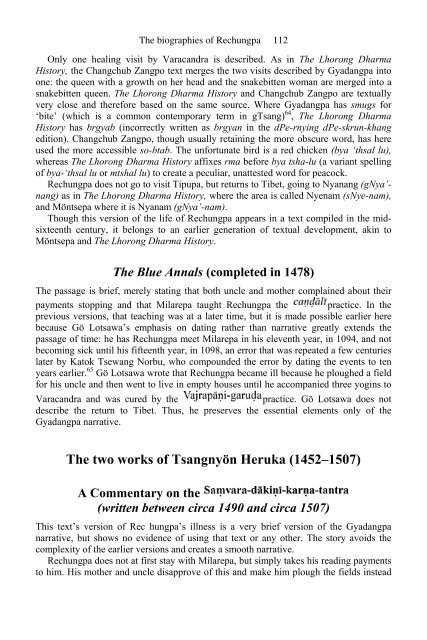The Biographies of Rechungpa: The Evolution of a Tibetan ...
The Biographies of Rechungpa: The Evolution of a Tibetan ...
The Biographies of Rechungpa: The Evolution of a Tibetan ...
Create successful ePaper yourself
Turn your PDF publications into a flip-book with our unique Google optimized e-Paper software.
<strong>The</strong> biographies <strong>of</strong> <strong>Rechungpa</strong> 112<br />
Only one healing visit by Varacandra is described. As in <strong>The</strong> Lhorong Dharma<br />
History, the Changchub Zangpo text merges the two visits described by Gyadangpa into<br />
one: the queen with a growth on her head and the snakebitten woman are merged into a<br />
snakebitten queen. <strong>The</strong> Lhorong Dharma History and Changchub Zangpo are textually<br />
very close and therefore based on the same source. Where Gyadangpa has smugs for<br />
‘bite’ (which is a common contemporary term in gTsang) 64 , <strong>The</strong> Lhorong Dharma<br />
History has brgyab (incorrectly written as brgyan in the dPe-rnying dPe-skrun-khang<br />
edition). Changchub Zangpo, though usually retaining the more obscure word, has here<br />
used the more accessible so-btab. <strong>The</strong> unfortunate bird is a red chicken (bya ‘thsal lu),<br />
whereas <strong>The</strong> Lhorong Dharma History affixes rma before bya tsha-lu (a variant spelling<br />
<strong>of</strong> bya-‘thsal lu or mtshal lu) to create a peculiar, unattested word for peacock.<br />
<strong>Rechungpa</strong> does not go to visit Tipupa, but returns to Tibet, going to Nyanang (gNya’nang)<br />
as in <strong>The</strong> Lhorong Dharma History, where the area is called Nyenam (sNye-nam),<br />
and Möntsepa where it is Nyanam (gNya’-nam).<br />
Though this version <strong>of</strong> the life <strong>of</strong> <strong>Rechungpa</strong> appears in a text compiled in the midsixteenth<br />
century, it belongs to an earlier generation <strong>of</strong> textual development, akin to<br />
Möntsepa and <strong>The</strong> Lhorong Dharma History.<br />
<strong>The</strong> Blue Annals (completed in 1478)<br />
<strong>The</strong> passage is brief, merely stating that both uncle and mother complained about their<br />
payments stopping and that Milarepa taught <strong>Rechungpa</strong> the practice. In the<br />
previous versions, that teaching was at a later time, but it is made possible earlier here<br />
because Gö Lotsawa’s emphasis on dating rather than narrative greatly extends the<br />
passage <strong>of</strong> time: he has <strong>Rechungpa</strong> meet Milarepa in his eleventh year, in 1094, and not<br />
becoming sick until his fifteenth year, in 1098, an error that was repeated a few centuries<br />
later by Katok Tsewang Norbu, who compounded the error by dating the events to ten<br />
years earlier. 65 Gö Lotsawa wrote that <strong>Rechungpa</strong> became ill because he ploughed a field<br />
for his uncle and then went to live in empty houses until he accompanied three yogins to<br />
Varacandra and was cured by the practice. Gö Lotsawa does not<br />
describe the return to Tibet. Thus, he preserves the essential elements only <strong>of</strong> the<br />
Gyadangpa narrative.<br />
<strong>The</strong> two works <strong>of</strong> Tsangnyön Heruka (1452–1507)<br />
A Commentary on the<br />
(written between circa 1490 and circa 1507)<br />
This text’s version <strong>of</strong> Rec hungpa’s illness is a very brief version <strong>of</strong> the Gyadangpa<br />
narrative, but shows no evidence <strong>of</strong> using that text or any other. <strong>The</strong> story avoids the<br />
complexity <strong>of</strong> the earlier versions and creates a smooth narrative.<br />
<strong>Rechungpa</strong> does not at first stay with Milarepa, but simply takes his reading payments<br />
to him. His mother and uncle disapprove <strong>of</strong> this and make him plough the fields instead











